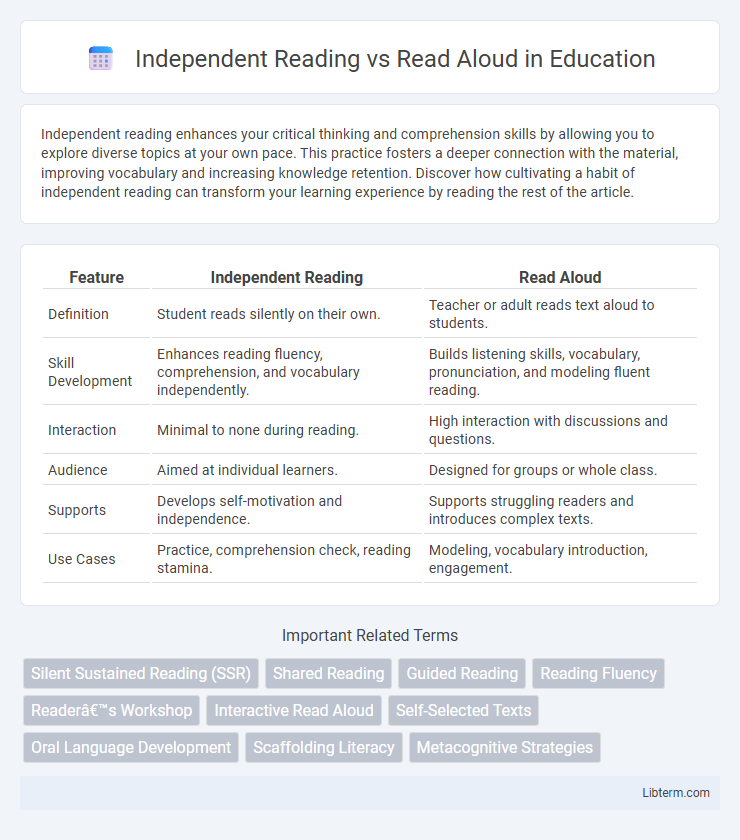Independent reading enhances your critical thinking and comprehension skills by allowing you to explore diverse topics at your own pace. This practice fosters a deeper connection with the material, improving vocabulary and increasing knowledge retention. Discover how cultivating a habit of independent reading can transform your learning experience by reading the rest of the article.
Table of Comparison
| Feature | Independent Reading | Read Aloud |
|---|---|---|
| Definition | Student reads silently on their own. | Teacher or adult reads text aloud to students. |
| Skill Development | Enhances reading fluency, comprehension, and vocabulary independently. | Builds listening skills, vocabulary, pronunciation, and modeling fluent reading. |
| Interaction | Minimal to none during reading. | High interaction with discussions and questions. |
| Audience | Aimed at individual learners. | Designed for groups or whole class. |
| Supports | Develops self-motivation and independence. | Supports struggling readers and introduces complex texts. |
| Use Cases | Practice, comprehension check, reading stamina. | Modeling, vocabulary introduction, engagement. |
Understanding Independent Reading
Independent reading fosters deeper comprehension by allowing readers to engage with texts at their own pace and according to their interests, promoting critical thinking and personal connection. It enhances vocabulary acquisition, fluency, and retention through repeated exposure and self-monitoring strategies. Unlike read alouds, independent reading empowers learners to develop autonomy and intrinsic motivation, which are crucial for long-term literacy success.
Defining Read Aloud Practices
Read aloud practices involve an educator or fluent reader vocalizing text to students, enhancing comprehension, vocabulary development, and listening skills through expressive and interactive reading. This method supports scaffolding by modeling fluent reading strategies and facilitating discussions that deepen understanding of complex texts. Unlike independent reading, read alouds focus on shared engagement and teacher-guided interpretation to build foundational literacy skills.
Cognitive Benefits of Independent Reading
Independent reading enhances cognitive development by fostering critical thinking, improving comprehension skills, and expanding vocabulary through self-paced engagement with diverse texts. It encourages metacognitive strategies, allowing readers to monitor their understanding and make inferences independently, which strengthens memory and analytical abilities. Unlike read-aloud sessions, independent reading promotes sustained attention and intrinsic motivation, critical for developing higher-order cognitive functions.
Language Development through Read Aloud
Read Aloud practices significantly enhance language development by exposing students to rich vocabulary, complex sentence structures, and expressive intonation that independent reading may not provide. Through interactive dialogue and immediate feedback during Read Aloud sessions, learners improve listening comprehension, pronunciation, and narrative skills more effectively. This dynamic approach fosters critical thinking and deeper understanding, accelerating language acquisition beyond the solitary experience of Independent Reading.
Building Reading Motivation: Independent vs. Read Aloud
Independent reading fosters intrinsic motivation by allowing readers to choose texts that align with their interests and reading levels, promoting autonomy and personalized engagement. Read aloud sessions build motivation through modeling fluent reading, exposing listeners to rich vocabulary and complex sentence structures, which enhances comprehension and instills a love for stories. Both methods complement each other by balancing personalized choice with guided literacy experiences, crucial for sustaining long-term reading motivation in diverse learners.
Social Interaction during Read Aloud Sessions
Read aloud sessions significantly enhance social interaction by fostering collaborative discussions and shared interpretations among participants, which promotes deeper comprehension and critical thinking. Unlike independent reading, read aloud experiences facilitate immediate feedback, peer engagement, and the development of communication skills through interactive dialogue and questioning. This social dynamic strengthens community building and supports diverse learners by providing a supportive environment for language acquisition and literacy development.
Fostering Critical Thinking in Independent Readers
Independent reading cultivates critical thinking by encouraging readers to engage directly with texts, analyze content, and form personal interpretations without immediate guidance. This autonomous process enhances comprehension skills, promotes deeper reflection, and nurtures the ability to evaluate and synthesize information independently. In contrast, read-aloud sessions primarily support listening comprehension and vocabulary development, offering less opportunity for active critical analysis by the reader.
Parental and Educator Roles in Both Approaches
Parental involvement in independent reading centers on providing access to diverse books and fostering a quiet, encouraging space, while educators guide personalized book selection to match student interests and skill levels. In read aloud sessions, parents actively engage by modeling fluent reading and discussing content to develop comprehension, whereas educators strategically choose texts that build vocabulary and listening skills. Both approaches rely on collaborative communication between parents and educators to reinforce reading habits and literacy development at home and school.
Choosing the Best Method for Diverse Learners
Independent reading fosters individualized comprehension and fluency by allowing learners to engage with texts at their own pace and interest, promoting autonomy and critical thinking. Read aloud sessions enhance listening skills, vocabulary acquisition, and model prosody, which benefits auditory learners and those with emerging literacy skills. Selecting the best method requires assessing learner profiles, including reading proficiency, learning style, and engagement levels, to tailor instruction that maximizes comprehension and motivation for diverse student needs.
Balancing Independent Reading and Read Aloud in Education
Balancing independent reading and read aloud in education enhances literacy development by combining student choice with guided comprehension. Independent reading fosters autonomy and fluency, while read aloud sessions model expressive reading and introduce complex vocabulary. Integrating both strategies supports diverse learning needs, promoting engagement and deeper understanding across grade levels.
Independent Reading Infographic

 libterm.com
libterm.com